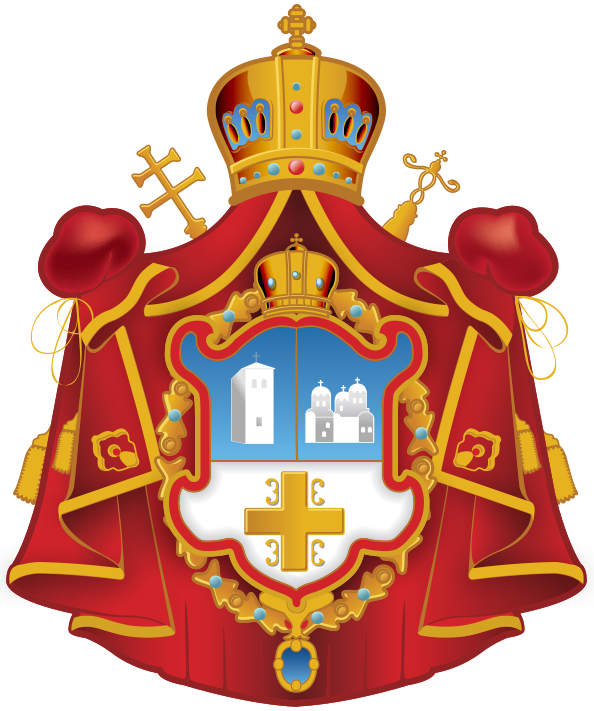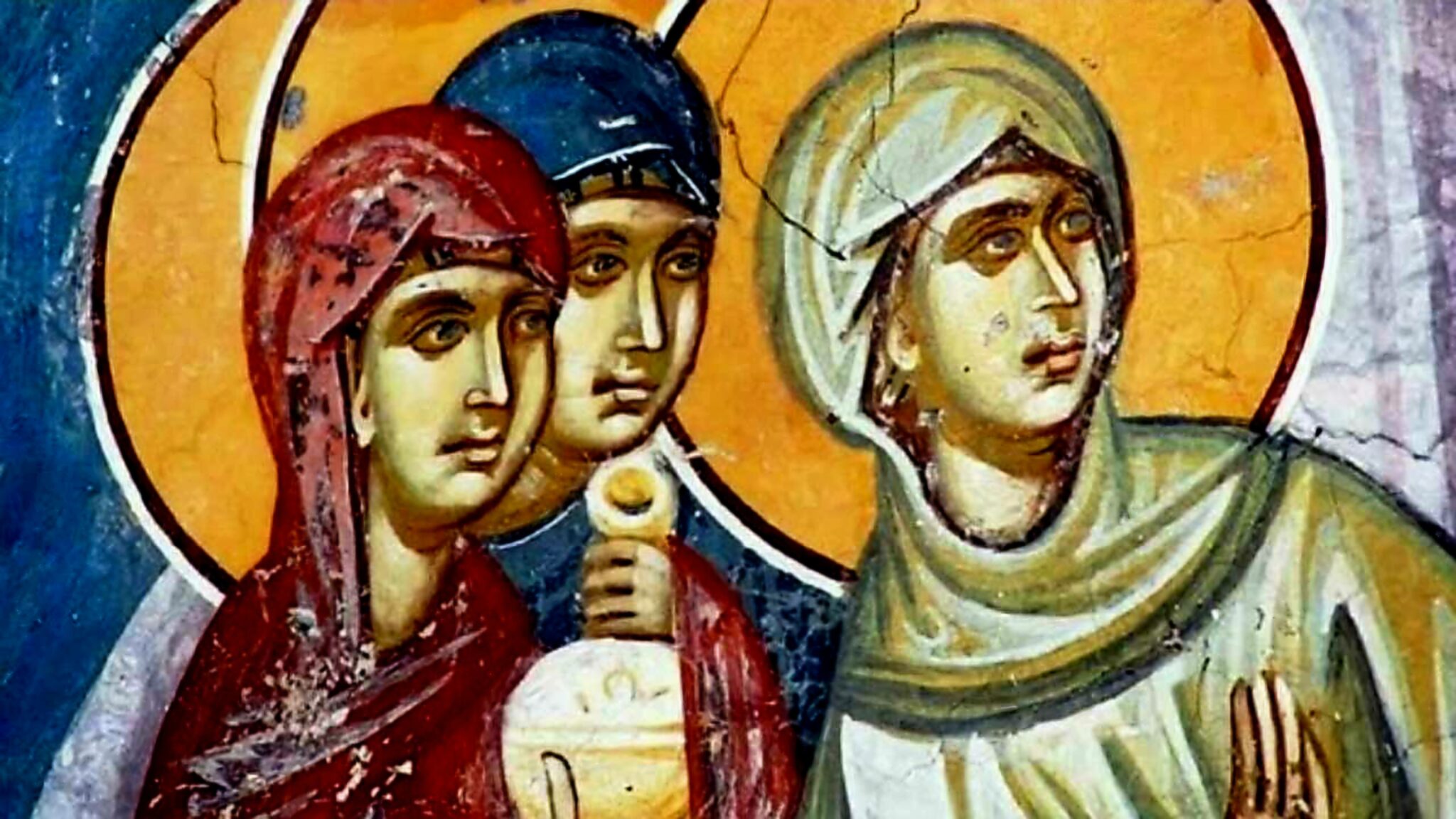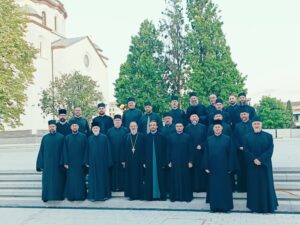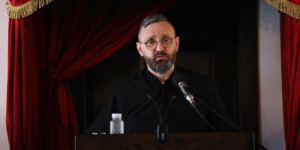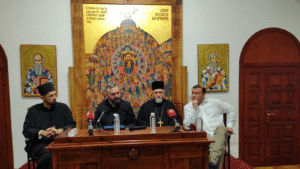On the third Sunday after the Feast of Feasts—the Resurrection of Christ—the Church liturgically commemorates and prayerfully glorifies the Holy Myrrh-bearing Women. This feast is dedicated to seemingly ordinary women—the disciples of Christ—who, without hesitation, followed their Teacher with love and zeal. They did not abandon their Lord even in those agonizing moments when the apostles had fled. In such exceedingly difficult times, the Myrrh-bearing Women demonstrated the greatest love, courage, and sacrifice toward their Lord, being ready even to lay down their lives for Him.
Because they had not managed to perform the burial rites due to the approaching Sabbath, the women hurried to the tomb on the third day after the crucifixion. They brought with them myrrh, a precious fragrant oil, intending to anoint the body of Jesus. Unconditional and boundless love inspired the Myrrh-bearing Women to run toward the tomb of Christ in the middle of the night. Their hearts were filled with pure faith and love, unencumbered by human logic. This great and pure faith was rewarded. As they approached the tomb, they saw the stone rolled away and the burial place open. Then the Angel of the Lord appeared and proclaimed that the One they sought had risen and was waiting for them in Galilee. They accepted this news through the eyes of faith and rushed back to the city to proclaim to the apostles the joy of the Resurrection. Their faith grew even stronger when they saw the Risen Lord.
From the scriptural witness, we learn that only Mary Magdalene remained at the tomb, not fully grasping the magnitude of the moment. When a man appeared before her, she assumed he was the gardener and asked where the body of her Teacher had been taken. However, when the “gardener” called her by name—in a way only one Man had ever spoken to her—she recognized Him: it was Christ Himself—alive, risen, and true. Her joy knew no bounds, for she saw with her own eyes the One whom she had been mourning with inconsolable grief alongside the other disciples.
The Lord later appeared to the other apostles and disciples who had been with Him during His three-year ministry. Yet, it was the Myrrh-bearing Women—those who did not fear the harsh Roman guards at the tomb nor any other danger—who first received the joyous news of the Savior’s Resurrection. They were moved by love—the same love that the Lord had planted in their hearts, a love that surpasses all things, even death itself.
These truths are set before us by the Church on the third Sunday after Pascha. We would not err in suggesting that this Sunday ought to be celebrated by all Christian women as their own feast. This festal day contains a wealth of profound lessons addressed to all, but especially to women. The Church extols on this day great sacrifice, selflessness, devotion, love, and above all, a living and fervent faith capable of overcoming all things. Every woman should strive to delve into the depths of the Gospel truths concerning the Myrrh-bearing Women and conform her life to them. This is particularly crucial in our present time, in which the sacred role of women is being undermined in various ways. The ultimate model for every woman is the Most Holy Theotokos, while the inspiration and guiding light are the Myrrh-bearing Women and their fearless faith.
The Church liturgically commemorates all the “hidden” figures—those who placed Jesus in the tomb—so that we may marvel at their courage. This is the courage of those who act far from the public eye and remain unknown to the world. The liturgical focus this week is especially directed toward the Myrrh-bearing Women. Although the Apostle Paul describes women as the “weaker vessel,” these women were unwavering and completely faithful. Because of this, the Risen Lord deemed them worthy to be the first to receive and proclaim the message of His glorious Resurrection. This is confirmed by the renowned Protopresbyter Alexander Schmemann, who writes:
“The coming of the Myrrh-bearers constantly reminds us that only their love and faithfulness shone in the hopeless darkness of Holy Week. Their going forth reminds us continually that neither faithfulness nor love have perished or disappeared from the world. Their coming forth condemns our faintheartedness, our fear, our perpetual and slavish self-justification. To the mysterious Joseph, to Nicodemus, and to those women who came to Christ’s tomb before the dawn—only a small space is devoted in the Gospel. Yet it is in their faithfulness that the eternal destiny of each one of us is determined.”
Seven or eight of Christ’s female disciples bear the title of Myrrh-bearers, although it is believed there were more. They later became fiery proclaimers of God’s word, and Mary Magdalene was even named Equal-to-the-Apostles due to the significance and magnitude of her preaching.
Who were the Myrrh-bearing Women?
Mary Magdalene was from the town of Magdala. She was the first person in the world to whom the Risen Savior appeared. After the Ascension, she preached in Rome and met with Emperor Tiberius, to whom she gave a chicken egg as a sign of the truth of the Resurrection. When the egg turned red in his hands, the blessed tradition of decorating and dyeing Paschal eggs was established.
Martha and Mary were the sisters of the Righteous Lazarus, whom the Savior had raised from the dead. Although not named in the Gospel among the women who went to the tomb, they are numbered among the Myrrh-bearers. Though sisters by birth, the Gospel (Luke 10:38–42) portrays them as possessing different temperaments: during the Savior’s visit, Mary sat at His feet and listened to His words, while Martha was busy with household tasks. After the Ascension, they went to Cyprus with their brother Lazarus, where he served as bishop.
Joanna was the wife of Chuza, a steward in the court of Herod Antipas. According to tradition, she discovered and buried the head of St. John the Baptist on the Mount of Olives.
Mary the wife of Cleophas is also numbered among the Myrrh-bearers. According to one tradition, she was the daughter of Joseph, the betrothed of the Theotokos. According to another, she was either the wife or daughter of Cleophas, mentioned in Luke 24:18.
Virtually nothing is known of Susanna. In the Gospel of Luke, she is mentioned as one of the women who served the Savior with her own means—indicating she was wealthy and financially supported His ministry.
Among the Myrrh-bearers is also Mary of James. Blessed Jerome identifies her with Mary of Cleophas, while St. John Chrysostom identifies her with the Theotokos.
Salome was the daughter of Joseph the Betrothed and the mother of the Holy Apostles John the Theologian and James. Almost nothing is known of her. The Evangelist Matthew refers to her as the mother of the sons of Zebedee. She, too, served the Savior during His earthly life. The Gospel notes that she was among the women watching from afar at the time of the Crucifixion (Matt. 27:55–56).
The crown of this meditation is expressed in the words of the kontakion for the third Sunday after Pascha:
“You commanded the Myrrh-bearers to rejoice and stilled the weeping of the first mother Eve by Your Resurrection, O Christ God. You instructed Your Apostles to proclaim: the Savior is risen from the tomb.”
Written by:
Catechist Branislav Ilić, Editor of the portal Koinonia
